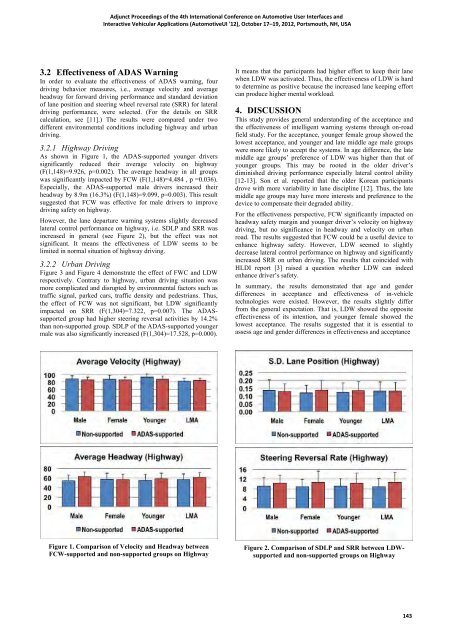12: Adjunct Proceedings - Automotive User Interfaces and ...
12: Adjunct Proceedings - Automotive User Interfaces and ...
12: Adjunct Proceedings - Automotive User Interfaces and ...
You also want an ePaper? Increase the reach of your titles
YUMPU automatically turns print PDFs into web optimized ePapers that Google loves.
<strong>Adjunct</strong> <strong>Proceedings</strong> of the 4th International Conference on <strong>Automotive</strong> <strong>User</strong> <strong>Interfaces</strong> <strong>and</strong><br />
Interactive Vehicular Applications (<strong>Automotive</strong>UI '<strong>12</strong>), October 17–19, 20<strong>12</strong>, Portsmouth, NH, USA<br />
3.2 Effectiveness of ADAS Warning<br />
In order to evaluate the effectiveness of ADAS warning, four<br />
driving behavior measures, i.e., average velocity <strong>and</strong> average<br />
headway for forward driving performance <strong>and</strong> st<strong>and</strong>ard deviation<br />
of lane position <strong>and</strong> steering wheel reversal rate (SRR) for lateral<br />
driving performance, were selected. (For the details on SRR<br />
calculation, see [11].) The results were compared under two<br />
different environmental conditions including highway <strong>and</strong> urban<br />
driving.<br />
3.2.1 Highway Driving<br />
As shown in Figure 1, the ADAS-supported younger drivers<br />
significantly reduced their average velocity on highway<br />
(F(1,148)=9.926, p=0.002). The average headway in all groups<br />
was significantly impacted by FCW (F(1,148)=4.484 , p =0.036).<br />
Especially, the ADAS-supported male drivers increased their<br />
headway by 8.9m (16.3%) (F(1,148)=9.099, p=0.003). This result<br />
suggested that FCW was effective for male drivers to improve<br />
driving safety on highway.<br />
However, the lane departure warning systems slightly decreased<br />
lateral control performance on highway, i.e. SDLP <strong>and</strong> SRR was<br />
increased in general (see Figure 2), but the effect was not<br />
significant. It means the effectiveness of LDW seems to be<br />
limited in normal situation of highway driving.<br />
3.2.2 Urban Driving<br />
Figure 3 <strong>and</strong> Figure 4 demonstrate the effect of FWC <strong>and</strong> LDW<br />
respectively. Contrary to highway, urban driving situation was<br />
more complicated <strong>and</strong> disrupted by environmental factors such as<br />
traffic signal, parked cars, traffic density <strong>and</strong> pedestrians. Thus,<br />
the effect of FCW was not significant, but LDW significantly<br />
impacted on SRR (F(1,304)=7.322, p=0.007). The ADASsupported<br />
group had higher steering reversal activities by 14.2%<br />
than non-supported group. SDLP of the ADAS-supported younger<br />
male was also significantly increased (F(1,304)=17.528, p=0.000).<br />
Figure 1. Comparison of Velocity <strong>and</strong> Headway between<br />
FCW-supported <strong>and</strong> non-supported groups on Highway<br />
It means that the participants had higher effort to keep their lane<br />
when LDW was activated. Thus, the effectiveness of LDW is hard<br />
to determine as positive because the increased lane keeping effort<br />
can produce higher mental workload.<br />
4. DISCUSSION<br />
This study provides general underst<strong>and</strong>ing of the acceptance <strong>and</strong><br />
the effectiveness of intelligent warning systems through on-road<br />
field study. For the acceptance, younger female group showed the<br />
lowest acceptance, <strong>and</strong> younger <strong>and</strong> late middle age male groups<br />
were more likely to accept the systems. In age difference, the late<br />
middle age groups’ preference of LDW was higher than that of<br />
younger groups. This may be rooted in the older driver’s<br />
diminished driving performance especially lateral control ability<br />
[<strong>12</strong>-13]. Son et al. reported that the older Korean participants<br />
drove with more variability in lane discipline [<strong>12</strong>]. Thus, the late<br />
middle age groups may have more interests <strong>and</strong> preference to the<br />
device to compensate their degraded ability.<br />
For the effectiveness perspective, FCW significantly impacted on<br />
headway safety margin <strong>and</strong> younger driver’s velocity on highway<br />
driving, but no significance in headway <strong>and</strong> velocity on urban<br />
road. The results suggested that FCW could be a useful device to<br />
enhance highway safety. However, LDW seemed to slightly<br />
decrease lateral control performance on highway <strong>and</strong> significantly<br />
increased SRR on urban driving. The results that coincided with<br />
HLDI report [3] raised a question whether LDW can indeed<br />
enhance driver’s safety.<br />
In summary, the results demonstrated that age <strong>and</strong> gender<br />
differences in acceptance <strong>and</strong> effectiveness of in-vehicle<br />
technologies were existed. However, the results slightly differ<br />
from the general expectation. That is, LDW showed the opposite<br />
effectiveness of its intention, <strong>and</strong> younger female showed the<br />
lowest acceptance. The results suggested that it is essential to<br />
assess age <strong>and</strong> gender differences in effectiveness <strong>and</strong> acceptance<br />
Figure 2. Comparison of SDLP <strong>and</strong> SRR between LDWsupported<br />
<strong>and</strong> non-supported groups on Highway<br />
143





